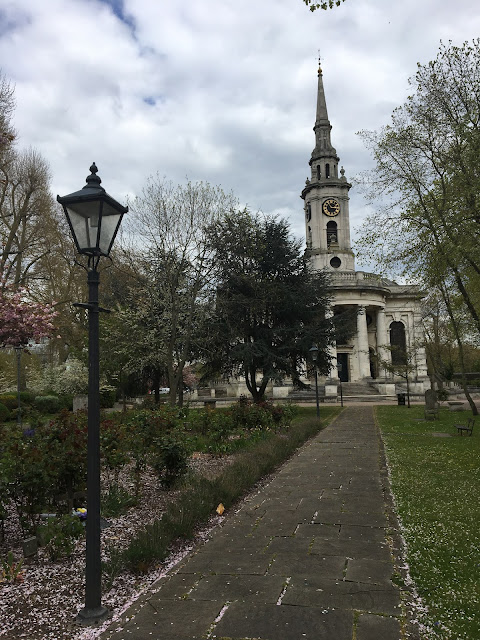I can remember being attracted to this church as I travelled down from London Bridge to Greenwich every day while doing a holiday job at the National Maritime Museum for £7.50 a week back in the late sixties! It was a landmark and I never forgot it. It was nearly 50 years later that I finally landed in Deptford to take a close look. It was locked. I returned last week in May 2021 and due to COVID of course no internal access except during services. I have documented my visit to the outside as you can see below. The internal pictures are courtesy of Wikipedia and Creative Commons. One day I shall get to a service. I know I shall feel very jealous because it looks such an ideal place of worship and with an organ in the right place!
 |
| I approach the church through the churchyard. |
John Leonard in "London's Parish Churches" (Breedon Books, 1997) reckons it is "the finest church in London south of the river". Also, of Thomas Archer 's (1668-1743) mature churches (St John's Smith Square, London and Birmingham Cathedral) it is the finest. It was built 1712-1730 and is one of those built under the Act for "Building...fifty new churches.." of 1711. This was passed by the new Tory Government and was a High Church initiative to expand church provision in the suburbs. In fact only 12 were built.
First sightings within the churchyard show a bold Italianate temple on a large platform. The dominant semi circular portico is reminiscent of Santa Maria della Pace, by Cortona, in Rome. I must post about this one day : it looks like a stage set at the end of its little square near Piazza Navona. St Paul's has no ballustrade above the portico, so the round tower comes shooting above the entrance like a rocket. This even reminds me of the wonderful Gothic spires from my Lincolnshire homeland. To me the spires symbolize the physical connection between heaven and earth and which is spiritually reflected through the Eucharist. Technically the portico and tower here are a good solution to the problem of how to combine an Italian portico with an English tower. St Paul's is so graceful compared to the large strange towers of Hawksmoor.
Walking around the church, magnificent on its plinth in the centre of an attractive churchyard, we see that to north and south there are symmetrical flights of stairs to two other arched doorways.
The curved apse at the usual east end has a large curved Venetian window. The church as a whole tries to reconcile High Church liturgical needs with Baroque spatial effects.
 |
| By John Salmon, CC BY-SA 2.0, https://commons.wikimedia.org/w/index.php?curid=51467578 |
The interior looks enormously impressive" and reminds John Summerson of St Agnese in Rome.(Architecture in Britain,1503-1830 , Penguin, 5th ed.1969). It is in effect a central square, with flat ceiling of fine plasterwork, flanked by Corinthian columns with galleries between. These galleries become more theatrical as they protrude near the apse. The apse provides the climax with its 18th century glass portraying the Ascension and with Archangels Michael and Gabriel either side. This is just about as near as we get in England to the Baroque idea of the theatrum sacrum with the high altar dominant, as at Diessen in Germany.
 |
| By John Salmon, CC BY-SA 2.0, https://commons.wikimedia.org/w/index.php?curid=51467568 |
Take an internal tour with this short little video
 |
| Farewell! Back some day soon! |





No comments:
Post a Comment